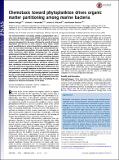| dc.contributor.author | Mitchell, James G. | |
| dc.contributor.author | Smriga, Steven | |
| dc.contributor.author | Fernandez, Vicente Ignacio | |
| dc.contributor.author | Stocker, Roman | |
| dc.date.accessioned | 2017-01-18T14:34:23Z | |
| dc.date.available | 2017-01-18T14:34:23Z | |
| dc.date.issued | 2016-01 | |
| dc.date.submitted | 2015-06 | |
| dc.identifier.issn | 0027-8424 | |
| dc.identifier.issn | 1091-6490 | |
| dc.identifier.uri | http://hdl.handle.net/1721.1/106519 | |
| dc.description.abstract | The microenvironment surrounding individual phytoplankton cells is often rich in dissolved organic matter (DOM), which can attract bacteria by chemotaxis. These “phycospheres” may be prominent sources of resource heterogeneity in the ocean, affecting the growth of bacterial populations and the fate of DOM. However, these effects remain poorly quantified due to a lack of quantitative ecological frameworks. Here, we used video microscopy to dissect with unprecedented resolution the chemotactic accumulation of marine bacteria around individual Chaetoceros affinis diatoms undergoing lysis. The observed spatiotemporal distribution of bacteria was used in a resource utilization model to map the conditions under which competition between different bacterial groups favors chemotaxis. The model predicts that chemotactic, copiotrophic populations outcompete nonmotile, oligotrophic populations during diatom blooms and bloom collapse conditions, resulting in an increase in the ratio of motile to nonmotile cells and in the succession of populations. Partitioning of DOM between the two populations is strongly dependent on the overall concentration of bacteria and the diffusivity of different DOM substances, and within each population, the growth benefit from phycospheres is experienced by only a small fraction of cells. By informing a DOM utilization model with highly resolved behavioral data, the hybrid approach used here represents a new path toward the elusive goal of predicting the consequences of microscale interactions in the ocean. | en_US |
| dc.description.sponsorship | National Science Foundation (U.S.) (Ocean Sciences Postdoctoral Fellowship) | en_US |
| dc.description.sponsorship | Gordon and Betty Moore Foundation (Marine Microbial Initiative Investigator Award GBMF 3783) | en_US |
| dc.language.iso | en_US | |
| dc.publisher | National Academy of Sciences (U.S.) | en_US |
| dc.relation.isversionof | http://dx.doi.org/10.1073/pnas.1512307113 | en_US |
| dc.rights | Article is made available in accordance with the publisher's policy and may be subject to US copyright law. Please refer to the publisher's site for terms of use. | en_US |
| dc.source | PNAS | en_US |
| dc.title | Chemotaxis toward phytoplankton drives organic matter partitioning among marine bacteria | en_US |
| dc.type | Article | en_US |
| dc.identifier.citation | Smriga, Steven et al. “Chemotaxis toward Phytoplankton Drives Organic Matter Partitioning among Marine Bacteria.” Proceedings of the National Academy of Sciences 113.6 (2016): 1576–1581. © 2016 National Academy of Sciences | en_US |
| dc.contributor.department | Massachusetts Institute of Technology. Department of Civil and Environmental Engineering | en_US |
| dc.contributor.mitauthor | Smriga, Steven | |
| dc.contributor.mitauthor | Fernandez, Vicente Ignacio | |
| dc.contributor.mitauthor | Stocker, Roman | |
| dc.relation.journal | Proceedings of the National Academy of Sciences | en_US |
| dc.eprint.version | Final published version | en_US |
| dc.type.uri | http://purl.org/eprint/type/JournalArticle | en_US |
| eprint.status | http://purl.org/eprint/status/PeerReviewed | en_US |
| dspace.orderedauthors | Smriga, Steven; Fernandez, Vicente I.; Mitchell, James G.; Stocker, Roman | en_US |
| dspace.embargo.terms | N | en_US |
| dc.identifier.orcid | https://orcid.org/0000-0003-2814-4586 | |
| dc.identifier.orcid | https://orcid.org/0000-0001-8344-9994 | |
| dc.identifier.orcid | https://orcid.org/0000-0002-3199-0508 | |
| mit.license | PUBLISHER_POLICY | en_US |
